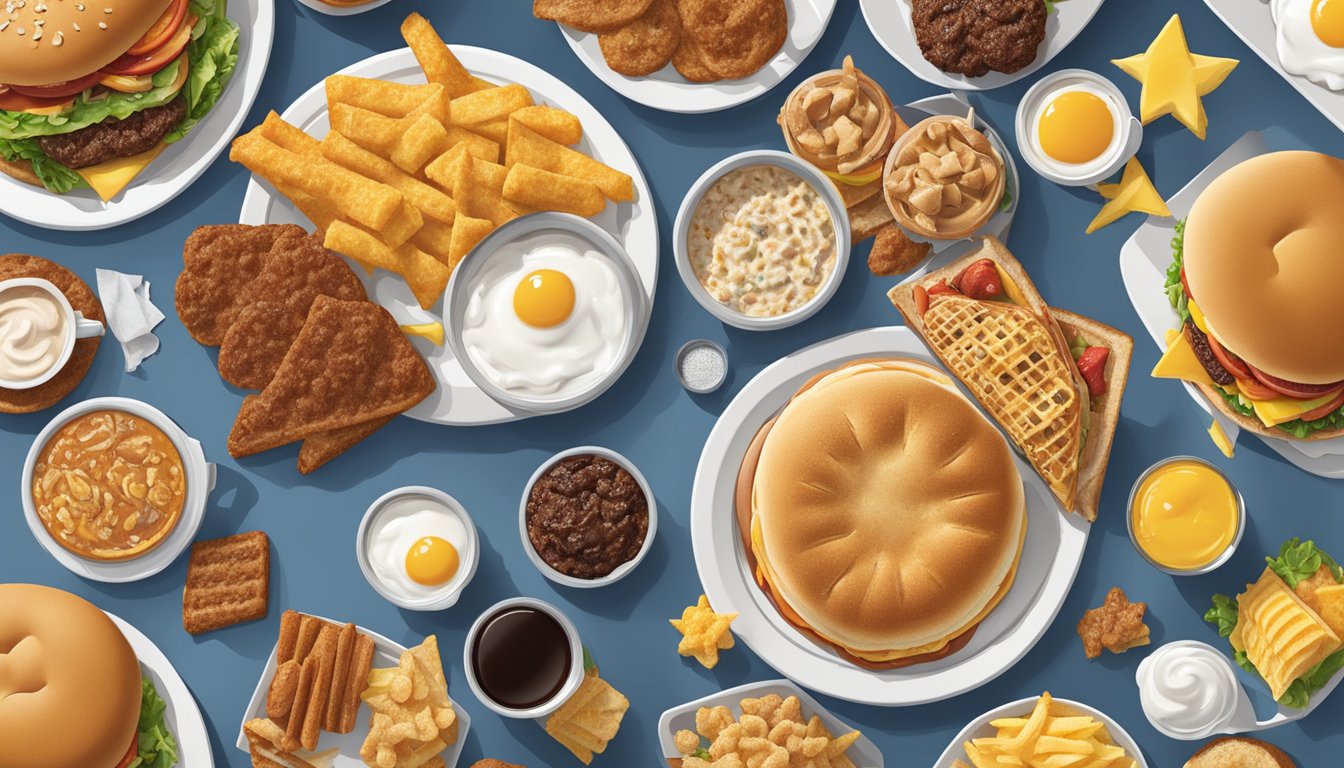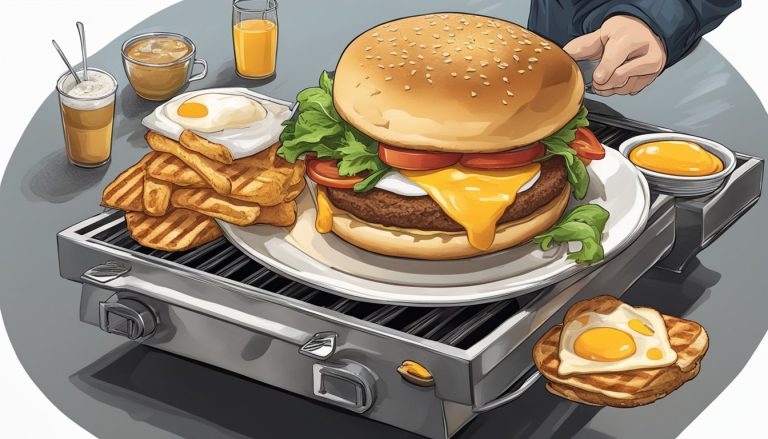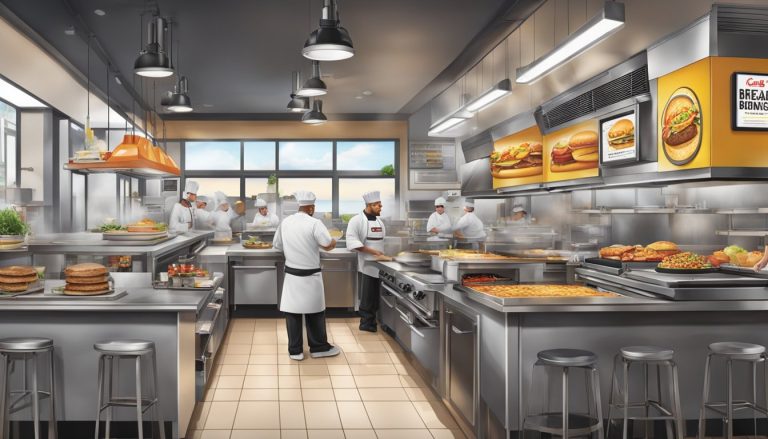Carl’s Jr., a fast-food chain born in California, has evolved from its humble hot dog stand origins to become a global brand. With over 1,600 restaurants in more than 25 countries, Carl’s Jr. has successfully exported its American-style offerings worldwide. The chain’s breakfast menu, featuring iconic items like breakfast burritos and grilled cheese breakfast sandwiches, has become a key part of its international appeal.
As Carl’s Jr. expanded beyond U.S. borders, it adapted its breakfast offerings to suit local tastes while maintaining its core identity. This global approach has allowed the brand to cater to diverse palates across different cultures. From Asia to Europe, Carl’s Jr. breakfast items have found their way onto morning menus, giving international customers a taste of California-inspired fast food.
The success of Carl’s Jr.’s global breakfast expansion demonstrates the universal appeal of quick, hearty morning meals. By blending familiar American flavors with local ingredients and preferences, Carl’s Jr. has positioned itself as a versatile player in the international fast-food breakfast market. This strategy has helped the brand establish a strong presence in new territories while staying true to its Californian roots.
History of Carl’s Jr.
Carl’s Jr. began as a small hot dog cart in Los Angeles and grew into a global fast-food chain. Its journey spans over 80 years of innovation and expansion in the quick-service restaurant industry.
Founding and Expansion
Carl Karcher and his wife Margaret launched their first hot dog cart in 1941 with just $326. Their initial day’s sales totaled $14.75. By 1945, they opened Carl’s Drive-In Barbecue in Anaheim, California. The first Carl’s Jr. restaurants debuted in 1956, marking the beginning of rapid growth.
In the 1960s, the business expanded significantly. Carl Karcher Enterprises, Inc. was formed, operating 24 Carl’s Jr. locations. The company renovated dining rooms and streamlined menus to enhance customer experience.
The 1970s saw further growth. By 1977, over 200 Carl’s Jr. restaurants served California. The chain introduced salad bars at all locations, becoming the first quick-service restaurant to do so.
CKE Restaurants and Global Growth
CKE Restaurants acquired Carl’s Jr. in 1997, accelerating its expansion. The company focused on franchising to drive growth both domestically and internationally.
Carl’s Jr. expanded beyond the West Coast, entering new U.S. markets and venturing overseas. By 2016, the chain had gained significant recognition, ranking 54th on Entrepreneur’s Top Franchise 500 list.
Today, Carl’s Jr. operates more than 1,600 restaurants across 25+ countries. The brand’s success stems from its quality products, modern restaurant design, and experienced international team.
Carl’s Jr. continues to innovate, adapting its menu and marketing strategies to suit diverse global markets while maintaining its California roots.
Carl’s Jr. Breakfast Menu Evolution

Carl’s Jr. has continually refined its breakfast offerings over the years, expanding from simple fare to a diverse menu that caters to global tastes. The chain’s breakfast evolution reflects changing consumer preferences and its international expansion.
Early Offerings and Innovations
Carl’s Jr. introduced breakfast items in the 1970s, starting with basic options like eggs and bacon. In the 1980s, they launched the Breakfast Burger, combining lunch and breakfast flavors. This innovative item became a signature dish, featuring a charbroiled beef patty topped with egg, bacon, and cheese.
The menu expanded to include biscuit sandwiches and breakfast burritos in the 1990s. Carl’s Jr. also introduced the Made From Scratch Biscuits™, baked fresh daily in each restaurant. These biscuits became the base for various sandwich options.
By the early 2000s, the breakfast menu featured:
- Loaded Breakfast Burrito
- Grilled Cheese Breakfast Sandwich
- French Toast Dips
Adapting to Global Tastes
As Carl’s Jr. expanded internationally, the breakfast menu adapted to local preferences. In Mexico, they added chorizo to breakfast burritos. Asian locations introduced rice-based breakfast bowls.
The chain also experimented with regional flavors:
- Jalapeño Poppers Breakfast Burrito in the Southwest US
- Maple-flavored items in Canada
Carl’s Jr. adjusted serving times to accommodate different cultural norms. While most US locations serve breakfast until 10:30 AM, some international outlets extended hours or offered all-day breakfast options.
Recent additions to the global menu include healthier choices like egg white sandwiches and protein-packed bowls. These items cater to health-conscious consumers worldwide.
Signature Breakfast Items
Carl’s Jr. has crafted a diverse breakfast menu that appeals to hearty appetites and international tastes. The chain’s signature items combine classic American breakfast flavors with innovative twists, satisfying customers around the globe.
Monster Biscuit and Other Favorites
The Monster Biscuit stands out as a Carl’s Jr. breakfast heavyweight. This imposing sandwich features a freshly-baked biscuit stuffed with eggs, bacon, sausage, and American cheese. It delivers a protein-packed start to the day for those with big appetites.
Another popular choice is the Grilled Cheese Breakfast Sandwich. It offers a comforting blend of melted American cheese, crispy bacon, and a folded egg between grilled sourdough bread. This item bridges the gap between breakfast and lunch cravings.
For those seeking a handheld option, the Loaded Breakfast Burrito wraps scrambled eggs, bacon bits, sausage, Hash Rounds, and cheese in a warm tortilla. Fresh salsa adds a zesty kick to this portable meal.
International Breakfast Specials
As Carl’s Jr. expanded globally, it adapted its breakfast menu to suit local tastes. In Mexico, customers can enjoy breakfast burritos with spicier flavor profiles and regional ingredients. The chain also offers churro-style French toast sticks in some Latin American locations.
In Asia, Carl’s Jr. has introduced rice-based breakfast bowls in countries like Thailand and the Philippines. These dishes often feature local proteins and seasonings while maintaining the hearty portion sizes the brand is known for.
European outlets have incorporated continental breakfast elements, such as croissant sandwiches and espresso-based coffee drinks, to cater to local preferences while still offering American-style options.
Nutritional Information and Health Considerations

Carl’s Jr.’s breakfast menu offers a range of options with varying nutritional profiles. Understanding the caloric content and ingredients can help customers make informed choices that align with their dietary needs and preferences.
Caloric Content and Ingredients
Carl’s Jr.’s breakfast items vary widely in calorie count. The Breakfast Burger contains 810 calories, while the Grilled Cheese Breakfast Sandwich with Ham has 490 calories. These sandwiches often include ingredients like folded eggs, American cheese, and meat options such as bacon or sausage.
Many breakfast items are high in protein. The Breakfast Burger provides 42 grams of protein, making it a substantial morning meal. Sodium content is notable, with the Grilled Cheese Breakfast Sandwich containing 1520mg, over half the daily recommended intake.
Carl’s Jr. uses a mix of ingredients in their breakfast menu. Eggs, cheese, and various meats form the core of many items. Biscuits and tortillas serve as the base for sandwiches and burritos.
Balancing Taste and Nutrition
Carl’s Jr. aims to balance flavor with nutritional value in their breakfast offerings. For those seeking lighter options, the menu includes items like the Bacon & Egg Burrito at 500 calories.
Customization can help manage nutritional intake. Removing cheese or opting for egg whites can reduce calorie and fat content. Adding vegetables to breakfast items can increase fiber and nutrient density.
For customers watching their carbohydrate intake, options like the Bacon, Egg & Cheese Biscuit provide 43 grams of carbs. Those looking to increase protein can choose items with additional meat or egg.
Carl’s Jr. provides nutritional information for their menu items. This transparency allows customers to make choices that fit their dietary goals while enjoying the taste of Carl’s Jr.’s breakfast offerings.
Operational Strategies for Breakfast Service
Carl’s Jr. has implemented specific operational strategies to deliver high-quality breakfast offerings efficiently. These strategies focus on extending breakfast hours and maintaining consistent food quality across locations.
Breakfast Hours and Accessibility
Carl’s Jr. serves breakfast from 6:00 AM to 10:30 AM daily at most locations. Some restaurants offer extended breakfast hours until 11:00 AM on weekends. This schedule allows early risers and late-morning customers to enjoy breakfast items.
The chain utilizes a “dual-menu” approach during breakfast-to-lunch transition periods. This strategy enables customers to order from both menus, maximizing sales and customer satisfaction.
Carl’s Jr. has also introduced all-day breakfast options at select locations. This move caters to the growing demand for breakfast items throughout the day.
Food Preparation and Quality Control
Carl’s Jr. employs a just-in-time cooking system for breakfast items. This approach ensures food freshness and reduces waste.
The chain uses standardized recipes and cooking procedures across all locations. This practice maintains consistency in taste and quality.
Key breakfast items like biscuits are made fresh in-store daily. Eggs are cracked and cooked to order, enhancing the perception of freshness.
Carl’s Jr. conducts regular quality audits at its restaurants. These audits assess food preparation techniques, ingredient quality, and overall breakfast service standards.
Staff receive specialized training on breakfast menu preparation. This training focuses on efficiency and maintaining quality during peak morning hours.
Comparative Analysis with Competitors

Carl’s Jr.’s breakfast offerings face stiff competition in the global fast-food market. The chain’s menu, pricing, and brand positioning play crucial roles in differentiating it from rivals like McDonald’s and Taco Bell.
Breakfast Offerings Across Fast-Food Chains
Carl’s Jr. emphasizes hearty, indulgent breakfast options. Their menu features items like the Monster Biscuit and Breakfast Burger. McDonald’s, the market leader, offers a wider variety of breakfast choices, including healthier options like oatmeal and yogurt parfaits. Taco Bell takes a unique approach with Mexican-inspired breakfast items such as breakfast burritos and Crunchwraps.
Hardee’s, Carl’s Jr.’s sister brand, shares many menu items but operates primarily in different regions. Both chains focus on made-from-scratch biscuits as a key differentiator.
Market Positioning and Brand Differentiation
Carl’s Jr. positions itself as a premium fast-food option, targeting young, hungry males. This contrasts with McDonald’s broader appeal to families and value-conscious consumers. Carl’s Jr.’s marketing often emphasizes large portion sizes and bold flavors.
Taco Bell appeals to a younger demographic with its quirky marketing and innovative menu items. The chain has successfully carved out a niche in the breakfast market with its unique offerings.
Price points vary across these chains. Carl’s Jr. typically commands higher prices than McDonald’s, reflecting its premium positioning. Taco Bell often offers competitive deals to attract budget-conscious customers.
Marketing and Promotional Tactics
Carl’s Jr. employs diverse strategies to promote its breakfast offerings globally. The company combines traditional advertising with digital marketing to reach customers across different markets and demographics.
Advertising Campaigns for Breakfast Rollouts
Carl’s Jr. creates targeted campaigns for new breakfast menu items in different regions. In the U.S., the company often uses celebrity endorsements and provocative ads to generate buzz. For international markets, Carl’s Jr. adapts its messaging to local tastes and cultural norms.
Television commercials showcase the chain’s signature breakfast sandwiches and biscuits. Print ads in magazines and newspapers feature mouthwatering images of breakfast platters. Billboards and outdoor advertising display eye-catching visuals of breakfast burritos and coffee.
Carl’s Jr. also utilizes radio spots and in-store promotions to drive traffic during morning hours. Limited-time offers and breakfast combo deals are prominently advertised to entice customers.
Leveraging Social Media and Digital Marketing
Carl’s Jr. maintains an active presence across major social media platforms. The company shares appetizing photos and videos of its breakfast menu items on Instagram and Facebook. Twitter is used for real-time engagement and to announce special promotions.
Influencer partnerships help Carl’s Jr. reach younger demographics. Food bloggers and social media personalities often feature the chain’s breakfast offerings in their content. Paid social media ads target specific audience segments in different countries.
Email marketing campaigns keep loyal customers informed about new breakfast items and deals. The Carl’s Jr. mobile app offers exclusive breakfast discounts and a rewards program. Online ordering and delivery partnerships expand the reach of the breakfast menu.
The Future of Breakfast at Carl’s Jr.

Carl’s Jr. is poised to expand its breakfast offerings globally while innovating its menu. The company aims to blend local flavors with its signature items to appeal to diverse international markets.
Innovation and Menu Development
Carl’s Jr. continues to push boundaries with its breakfast menu. The chain recently introduced a Spicy Breakfast Burger, combining morning flavors with a kick of heat. This move demonstrates their commitment to bold, unique offerings.
Future innovations may include:
- Plant-based breakfast options
- Customizable breakfast bowls
- Healthier alternatives using whole grains and fresh fruits
Carl’s Jr. is likely to experiment with fusion cuisine, incorporating international ingredients into classic American breakfast items. This approach could result in exciting new products that cater to evolving consumer tastes.
Expanding Global Reach
Carl’s Jr.’s global strategy focuses on adapting its breakfast menu to local preferences. The chain currently operates in 28 countries, with plans for further expansion.
Key aspects of their international breakfast strategy include:
- Tailoring menu items to regional tastes
- Partnering with local suppliers for fresh ingredients
- Adjusting portion sizes to suit different markets
In some countries, Carl’s Jr. may extend breakfast hours beyond the typical 6:00 AM to 10:30 AM window to accommodate varying cultural norms. This flexibility could help the brand gain a competitive edge in new markets.




